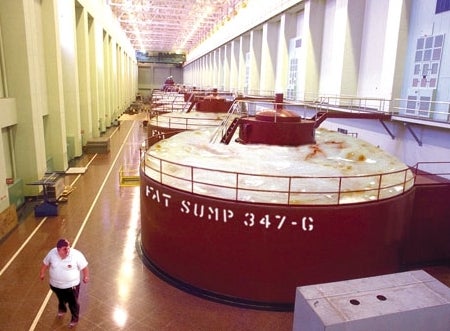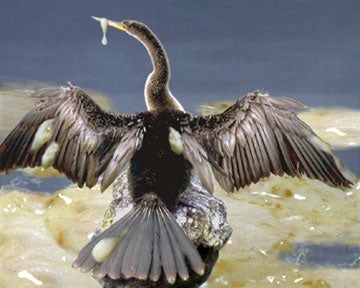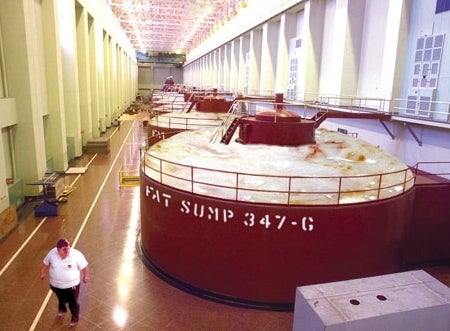WASHINGTON, DC—Unable to keep pace with the fat-storage needs of an increasingly prosperous, inactive and consumptive American populace, the nation’s 140,000 federal fat-reserve tanks are in danger of bursting their seams and discharging several billion gallons of clotted human fat into sensitive ecosystems across the U.S., Department of the Interior officials said Monday.

“On Wednesday, Sept. 17, at 11:23 a.m. EST, the federal fat reserves reached their official absolute design limit,” Deputy Interior Secretary Richard Rominger said. “A crisis state now exists during which the Department of the Interior will operate its fat-pipeline and tank-storage units under emergency conditions only.”
The fat reserves, estimated to hold 230 billion gallons of excess U.S. lipids, adipose tissue and cellulite, have now been packed into triple-hulled steel tanks at up to four times standard pressure, seriously threatening the structural integrity of the system. Federal fat-management personnel, using computer flab-flow monitoring systems, project that the reserves will suffer at least one major rupture in the next three months. Further, almost all of the tanks have experienced overflow conditions ranging from minor lard seepage to explosive catastrophic weld failure.
“What we’re dealing with here is a simple but dangerous overpressure problem,” said James Soto, a federal fat dynamicist. “The tanks in question are reinforced, three-bulkhead solid/liquid fat-scavenging designs made of roll-tempered high-tungsten steel, feeding off a centrifugal fat-recovery slurry turbine. But some of them are over 30 years old, and we’ve packed them with raw, semi-solid human-obesity by-products at pressures nearing 13 fatmospheric units. That’s 13 times the pressure found in the stomach region of your average 300-pound man.”
Until the crisis passes and more room can be made in the tanks, the government is urging Americans to try to fit a little more weight on their frames.
“If everyone could just squeeze on three or four extra pounds—whether it be in the thighs, the hips or even, in some extreme cases, the ankles and wrists—it would tremendously help relieve the strain on our badly overtaxed national fat reserves,” Rominger said. “We realize that most Americans are already doing their part, carrying as much fat as humanly possible, but this truly is an emergency situation.”

“Again, I want to stress,” Rominger said, “we are not asking Americans to lose weight. We’re simply asking them to carry around a few extra pounds until the system is up and running again.”
The Federal Fat Reserve system was established by an act of Congress in September 1965, after a government study projected that Americans would run out of fat-storage space on their bodies by 1980. Originally designed as a network of pipelines and storage tanks with an initial nominal volume of 43 million barrels, the system has been upgraded numerous times over the past three decades, reaching an upper limit of 775 million barrels in 1992.
“Unfortunately, a number of recent American lifestyle trends, including super-sizing, an expanded offering of cable TV channels, and the new, even more delicious taste of Jennie-O brand breakfast sausages, have placed an unbelievable strain on our nation’s fat reserves,” Rominger said. “The U.S. girth rate has been so explosive, it’s been almost impossible for our storage facilities to keep up. To give you an idea of what we’re talking about, in the past five years, the national pant size has soared from 36 to a whopping 48.”
Exacerbating the current crisis, some of the most overburdened fat tanks are situated near ecologically sensitive areas such as the New England shoreline, Lake Charles in Louisiana, and the headwater region of the Mississippi River, just north of St. Paul, MN.
The Department of the Interior wishes to avoid incidents such as the infamous Cleveland Fat Disaster of 1983, in which 24 people lost their lives and hundreds more were injured when a tanker hit and ruptured an underwater fatline in Lake Erie. The rupture caused a 17 million gallon fat spill, coating the Cleveland harbor in an 18-inch layer of human suet which subsequently caught fire and caused $40 million in damage to the city’s downtown.
At least one ecosystem has already felt the effects of the current crisis. Some 250 fat-holding tanks in South Florida suffered total structural failure Tuesday, flooding the Everglades with streams of glistening, pink, basketball-sized lumps of lard drained from the bodies of some 40,000 buffet-going Pompano Beach retirees. At least 15 Everglades species, including the Florida crested tern and the swath-bellied kingsnake, are in danger of extinction as a result of the floating chunks of slowly decomposing necrotic flab.
“The disappearance of species from our planet and the wholesale destruction of our ecosystems is only the beginning,” said Raymond Thorne, director of Florida’s Department of Conservation. “If the U.S. government doesn’t start getting serious about expanding federal fat reserves now, the American people themselves may one day suffer, forced to ease up on the ham-and-cheese omelettes, Pringles potato chips, juicy prime rib, and rich, creme-filled pastries that no person should ever have to live without.”







